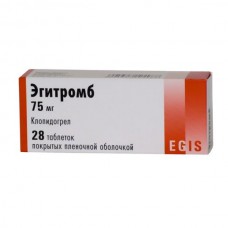Expiration date: 04/2026
The composition and form of issue:
Tablets, film-coated. 1 tablet contains:
clopidogrel hydrosulfate 97,86 mg
(in terms of clopidogrel — 75 mg)
excipients: cellulose microcrystalline silicon (microcrystalline, silica colloidal anhydrous) hyprolose (with a low degree of substitution (L-HPC B1) castor oil hydrogenated Opadry white Y-I-7000 (hypromellose, titanium dioxide, macrogol 400)
in packages contour 7 PCs in cardboard pack 2 or 4 packs.
Description pharmaceutical form:
White or almost white round biconvex tablets, film-coated, engraved with "E 181" on one side of the tablet, without or almost without smell.
Pharmacokinetics:
Clopidogrel is rapidly absorbed after repeated ingestion of 75 mg a day. Bioavailability of high. However, the concentration of the original substance in the plasma is low and after 2 h does not reach the measurement limit (0,025 µg/l). The plasma protein binding 98%. Metabolized in the liver. The main metabolite — inactive derivative carboxylato acid Tmax which after repeated oral doses of 75 mg 1 h (Cmax about 3 mg/l).
Display memory — 50% and through the intestines with the stool — 46% (during 120 h after injection).
T1/2 the main metabolite after single and repeated administration — 8 h.
The concentration of the main metabolite in plasma after administration of 75 mg/day lower in patients with severe renal disease (creatinine Cl — 5-15 ml/min) compared with the patients with kidney disease of moderate severity (creatinine Cl — 30-60 ml/min) and healthy subjects.
Description pharmacological action:
Antiplatelet drug specific and active inhibitor of platelet aggregation. Selectively reduces the binding of adenosine diphosphate (ADP) receptors on platelets and activation of receptor GPIIb/IIIa by the action of ATP, thus impairing platelet aggregation.
Reduces agregatia platelets, caused by other agonists, preventing activation of the released ADP, does not affect the activity phosphodieterase (PDE). Irreversibly binds to ADP-receptors platelets, which remain impervious to the stimulation of ADP throughout the life cycle (about 7 days).
Inhibition of platelet aggregation observed after 2 h after administration (40% inhibition) initial dose of 400 mg. the Maximum effect (60% suppression of aggregation) develops after 4-7 days of admission in a dose of 50-100 mg/day. Antiplatelet effect lasts for the entire period of life of platelets (7-10 days).
In the presence of atherosclerotic lesions of the vessel prevents the development of atherothrombosis regardless of the localization of vascular process (cerebrovascular, cardiovascular or peripheral lesions).
Indications:
- prevention of thrombotic complications in patients with myocardial infarction, ischemic stroke or peripheral arterial occlusion
- to prevent thrombotic complications of acute coronary syndrome in combination with acetylsalicylic acid (ASA): with ST-segment elevation when possible, use of thrombolysis, without increasing segmentat (unstable angina, myocardial infarction without Q wave), including patients undergoing stenting.
Contraindications:
- hypersensitivity to any active or auxiliary component of the drug
- severe liver failure
- active pathological bleeding (peptic ulcer or intracranial hemorrhage)
- pregnancy and lactation (see "Pregnancy and lactation")
- the age of 18 years (the efficacy and safety of not proven).
Caution: moderate hepatic insufficiency, chronic renal failure (CRF), pathological conditions that increase the risk of bleeding (including trauma, surgery), concomitant use of ASA, NSAIDs (including COX-2 inhibitors), heparin and inhibitors of receptor glycoprotein IIb/IIIa
Application of pregnancy and breast-feeding:
Due to the lack of clinical data of the drug in pregnant should not be prescribed clopidogrel during pregnancy.
Information about the allocation of breast milk in humans, so the use of the drug during lactation is contraindicated.
Side effects:
Bleeding — the most frequent adverse reaction, most often it occurs during the first month of treatment. The cases of severe bleeding was in patients receiving clopidogrel simultaneously with ASA or clopidogrel with ASA and heparin (see "Special instructions").
The frequency of side effects is defined as follows: often — >1/100–<1/10, uncommon — >1/1000–<1/100 and rare >1/10000–<1/1000 very rare <1/10000. Within each frequency class the undesirable effects are presented in order of decreasing severity.
CNS: rarely — headache, dizziness and paresthesia rarely — systemic dizziness very rarely — confusion, hallucinations, disorders of taste sensations.
By the blood: often — gastrointestinal bleeding, diarrhea, abdominal pain, dyspepsia, rarely — hemorrhagic stroke, gastric ulcer, duodenal ulcer, gastritis, nausea, vomiting, constipation, flatulence very rare — pancreatitis, colitis (including ulcerative or lymphocytic colitis), stomatitis acute liver failure, hepatitis.
From the cardiovascular system and the hemopoietic system: rarely — increased bleeding time and decreased platelet count (thrombocytopenia) leukopenia, neutropenia and eosinophilia is very rarely — vasculitis, hypotension, thrombotic thrombocytopenic purpura (TTP) (1/200000 of patients receiving drug) (see "Special indications"), severe thrombocytopenia (platelet count <30·109/l), agranulocytosis, granulocytopenia, aplastic anaemia/pancytopenia, anaemia.
With the skin: rare — allergic reactions (skin rash), pruritus very rare — angioedema, bullous dermatitis (erythema multiforme, Stevens-Johnson syndrome, toxic epidermal necrolysis), rash erythematous, urticaria, eczema and oral lichen planus.
From the side of respiratory system: very rarely — bronchospasm, interstitial pneumonitis.
Other: very rarely — arthralgia, arthritis, myalgia, anaphylactoid reactions, serum sickness, fever, disturbances in liver function tests, increased level of blood creatinine, the glomerulonephritis.
Drug interactions:
Enhances the antiplatelet effect of ASA, heparin, thrombolytics, anticoagulants, NSAIDs, increases the risk of bleeding from the digestive tract, so the simultaneous use of these funds requires caution.
Clopidogrel should be used with caution in patients who may have increased bleeding risk in trauma or surgical intervention in case of simultaneous administration of inhibitors of receptor glycoprotein IIb/IIIa.
The simultaneous use of clopidogrel and warfarin is not recommended because it may intensify the bleeding (see also section "Special instructions").
Not detected clinically significant pharmacodynamic interactions in cases of simultaneous use of clopidogrel with atenolol, nifedipine or the combination of atenolol with nifedipine. Furthermore, the pharmacodynamic activity of clopidogrel was not significantly altered by the coadministration of phenobarbital, cimetidine or estrogen.
The pharmacokinetics of digoxin or theophylline was not altered by simultaneous administration of clopidogrel. Antacids do not affect absorption of clopidogrel.
The study of the liver human microsomes demonstrated that the metabolite of clopidogrel is related to carboxylic acids, can inhibit the activity of cytochrome ?4502?9. This can increase the levels in blood plasma of drugs, such as phenytoin, tolbutamide and the NSAIDs, which are metabolized by cytochrome ?4502?9. Phenytoin and tolbutamide can be safely used in conjunction with clopidogrel.
Method of application and dose:
Inside, regardless of meals.
Adults and elderly clopidogrel should be taken for 75 mg 1 time per day.
Treatment should begin within several to 35 days in patients after myocardial infarction and from 7 days to 6 months in patients after ischemic stroke.
In acute coronary syndrome without ST-segment elevation (unstable angina or myocardial infarction without Q wave) clopidogrel should be started with a single loading dose 300 mg and then continue taking 75 mg 1 time per day in combination with ASA (dose of 75-325 mg/day). Since higher doses of ASA are associated with an increased risk of bleeding, we recommend to prescribe it in doses not higher than 100 mg clinical trial Data indicate the possibility of the drug up to 12 months and a maximum clinical benefit is seen after 3 months.
Acute myocardial infarction with ST-segment elevation. Clopidogrel should be taken for 75 mg 1 time per day treatment should be initiated with a loading dose and in combination with ask and of thrombolytics or without them. Patients older than 75 years, the rate of clopidogrel should be appointed without initial loading dose. Combination therapy should begin as soon as possible after the onset of symptoms and last for at least 4 weeks. Experience of application in children is absent.
Overdose:
Symptoms: overdose of clopidogrel may extend bleeding time and may cause complications associated with bleeding.
Treatment: upon detection of bleeding should be assigned the appropriate treatment. If necessary, the rapid reduction of the prolonged time of bleeding, platelet transfusion can eliminate the effects of clopidogrel. Not discovered antidotes pharmacological activity of clopidogrel.
Special instructions:
During treatment necessary to monitor the indicators of hemostasis system (activated partial thromboplastin time (APTT), number of platelets, tests of functional activity of platelets) regularly examine the functional activity of the liver.
Clopidogrel should be used with caution in patients with increased bleeding risk in trauma, surgical intervention, patients with injuries that predispose to bleeding (particularly gastrointestinal and intraocular), and in patients receiving ASA, NSAIDs (including COX-2 inhibitors), heparin, or inhibitors of receptor glycoprotein IIb/Sha. The patients should be carefully monitored to detect any signs of bleeding, including concealed, especially during the first weeks of the drug and/or after invasive procedures on the heart or surgery. The simultaneous use of clopidogrel and warfarin is not recommended since it can increase bleeding. In the case of surgery if antiplatelet effect is undesirable, the treatment should be discontinued 7 days before surgery.
Patients should be warned that because the stop occurs on the background of the use of clopidogrel (in combination with ASA or no) bleeding requires more time, they should inform the doctor about each case, unusual bleeding. Patients should also inform the doctor about the drug if they have surgery, and before taking any new drug.
After taking clopidogrel TTP were detected very rarely, sometimes after short-term use. This condition is characterized by thrombocytopenia and microangiopathic hemolytic anemia in combination with neurological signs, impaired kidney function or fever. TTP is a potentially fatal condition that requires immediate treatment, including the use of plasmapheresis.
Due to the lack of data, clopidogrel cannot be recommended in acute (less than 7 days) ischemic stroke.
Experience with the use of clopidogrel in patients with impaired renal function is limited, therefore, these patients clopidogrel should be administered with caution.
In severe liver dysfunction should be aware of the risk of developing hemorrhagic diathesis, experience with the drug in patients with moderate hepatic impairment is limited, therefore, these patients clopidogrel should be administered with caution.
Effects on ability to drive vehicles and operate machinery. Clopidogrel does not affect or slightly affect the ability to drive vehicles and operate machinery.


